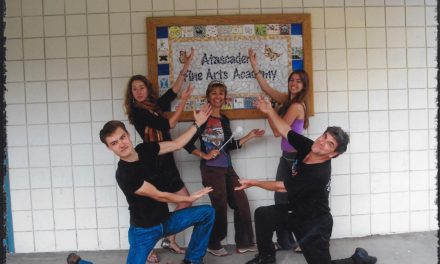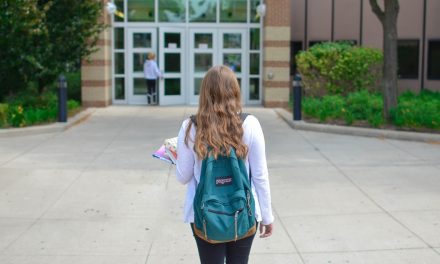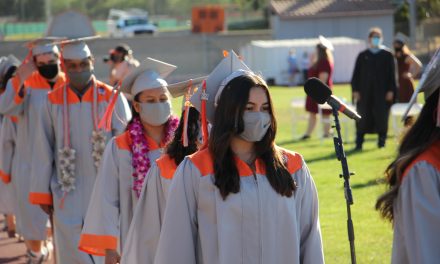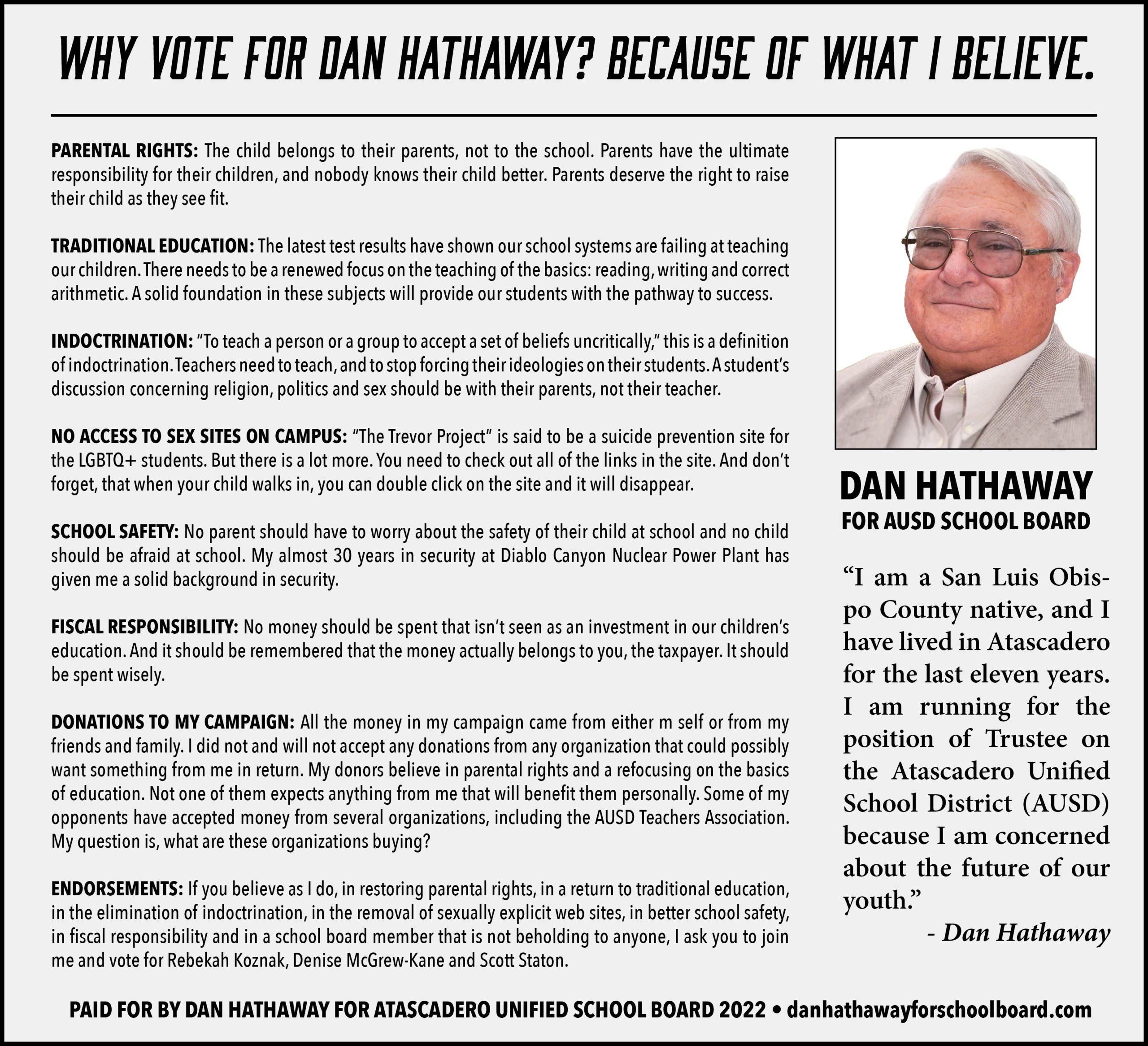Contingent advocates for additional teachers, middle school levels for district’s remote campus
ATASCADERO — In a busy regular meeting on Tuesday, May 6, the Atascadero Unified School District Board of Trustees discussed the situation of Carissa Plains Elementary School after hearing from a group of parents and students who came from the area, 45 miles from Atascadero.
The discussion of CPES was already an item on the agenda under Administrative Business, but a group of students and parents from the K-5 school made the trip to request a new middle-school-level teacher so that students can stay with the campus through the eighth grade. Currently, the students need to be bused into Atascadero for school starting with the sixth grade.
The amount of time students would spend on the bus before and after school has been a main point of concern for the parents, which was also expressed at the April 1 school board meeting.
In Tuesday’s meeting, five speakers came to the podium to voice support for the school and lobby for the expansion of grade levels, while a group of students and parents held up signs reading “Bussing Polecats Stinks,” referencing the school’s mascot.
Adrienne Twisselman, a parent of two current CPES students who identified herself as spokesperson of the school’s Parents, Teachers, and Friends Group, spoke about the past history of the school.
Twisselman noted that the area had been served by a K–8 school for 50 years until about a decade ago, when the district reduced it to a K–5 school and began busing students to Atascadero for middle school.
“According to the superintendent’s office, the busing decision was made without any study or supporting data as to how students would benefit,” she said. “Carissa Plains’ Parents, Teachers, and Friends Group has requested that data and was told it was unavailable.”
Twisselman continued, “AUSD’s stated commitment to community partnership rings hollow when rural families raise valid concerns and are met with silence. We’re not asking for special treatment, we’re looking to be heard.”
Another speaker, Cami Cloward, said she had been a student at CPES when it was a K-8 school, and compared her experience to that of her daughter, who went to Templeton Middle School.
“It was sad to see the things she didn’t get to do in junior high that I got to do when I was at Carissa Plains,” Cloward said. “The community that we have, I was able to learn how to public speak, which I brought into my career today…I was able to be in plays and productions where we did not get stage fright. Those are the things I got while at Carissa Plains. The kids I see today aren’t getting that.”
Patty Hermosillo, a member of the Carissa Plains Parents, Teachers and Friends group, offered up a number of “truths” about the students’ experience having to travel such a long way to school, and the rationale for the distict having that situation. Many of them had to do with the effect of students’ mental and physical health having to ride on a bus for “four hours” a day, as well as the burden it puts on the families.
She also said the school has donations lined up to expand the grades and hire a new teacher, but they are now on hold due to the uncertainty with the district.
Later in the meeting, the board commenced on the Administrative Item on CPES.
While Butler said he appreciated the input from the CPES, he found that busing the students to city middle schools has been beneficial.
“I certainly want to honor the Carissa Plains parents’ opinions on the education of their children, but we’ve generally found that the kids going to Atascadero Middle School or the Fine Arts Academy generally do well,” Butler said.
Butler then gave a quick background as to why the school changed to K-6. “In February 2008, Carrisa Plains shifted to being a K–6 school. Later, in February 2011, the Board of Education organized a Citizens Advisory Committee and asked them to evaluate the structure of our elementary schools, including Carrisa Plains, Creston, and Santa Margarita, and to consider the best way to serve the middle grades.”
Butler continued, “That committee — made up of community members, parents, teachers, and other stakeholders — met and presented their recommendations to the board: implement a K–5 elementary model and a 6–8 model for middle school. The board approved the recommendation that same month. Of course, that required construction to support the shift. Thanks to a bond measure, the larger Atascadero Middle School was eventually built to accommodate the students. Implementation was phased in, but by February 2017, all elementary schools —including Carrisa Plains — were operating under the K–5 model, and all 6th graders either attended Atascadero Middle School, the Fine Arts Academy, or the Atascadero Choices in Education independent study program.”
Assistant Superintendent for Business Services Kendyl Darnell pointed out that getting “small school” funding from the state was difficult because of the size of AUSD as a whole, and also pointed out that to get funding for a third teacher, the school would need to have an average daily attendance figure of 49 students, and CPES currently has a rate of 20.
Ultimately, the trustees wanted to assure the Carissa Plains parents that their concerns were being considered, even if the result might not be what they want.
“I assure the parents we’re taking this seriously,” said Trustee Rebekah Kozek. “There are a lot of steps to take, and the process is just starting.”
In other business at the meeting:
Atascadero High School Principal Nikki Baca did a year-in-review presentation to the board and announced that AHS has earned accreditation for the next six years. In a recent audit for the accreditation, Baca said the school was praised for, among other things, its welcoming environment, counseling support, and Career and Technical Education pathway. However, Baca said, the school still seeks improvement in absenteeism, more parental involvement, and increased rigors in instruction.
The board passed 10 business items, including certification of general bonds passed in the November 2024 election, the establishment of a Citizen’s Oversight Board for Measure B-24 fund, improvements at various campuses and the district office, and the establishment of a position of Coordinator of Program Compliance, in charge of overseeing compliance for student attendance, state, and federal programs.
The AUSD board will meet next on Tuesday, May 20, at 7 p.m.
The board also heard from Atascadero High School Principal Nikki Baca, who made a year-in-review presentation on her school.















